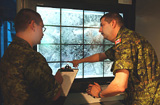                 |
|
 As indicated in the description of our fields of expertise, we are qualified to develop and supply computer techniques and architecture; information management units and systems; tools to improve the efficiency of the decision-making cycle; and simulation procedures. A number of scientific publications have been published on these subjects. Consult our portfolio of achievements. Capabilities

Knowledge Management SystemsInvestigation and improvement of knowledge creation and discovery techniques through the collecting and processing of appropriate data to grasp the meaning of the current situation, and projecting possible future courses of action or trends, thus realizing that such techniques must handle knowledge about entities that transcend space and time; human knowledge representation modelling in meaningful and intuitive ways to facilitate navigation, storage and retrieval, while considering environments adapted to user profiles and task-oriented workspaces.CapabilitiesKnowledge creation (e.g. data fusion, knowledge modelling and representation, ontology) and discovery (e.g. data mining, data warehousing, integrated reasoning tools, visualization). Information sciences (e.g. information theory and knowledge management) that quantify and transform data, information and knowledge. Collaborative analysis tools allowing multiple analysts, often geographically distributed, to work on a common subject through shared workspaces.Visualization and Geospatial SystemsInvestigation and improvement of techniques for multi-dimensional information management, analysis and visualization to enhance the understanding of spatial and time-related knowledge. These techniques should also facilitate the discovery of knowledge in complex environments. Particular emphasis is placed on exploiting the urban landscape as well as multi-dimensional information.CapabilitiesGeomatics including urban/3D. Data warehousing. Spatial On-Line Analytic Processing. Data generalization and data structures for heterogeneous, multi-dimensional and multi-type data. Massive data sets management. Visualization. Virtual reality. New media.Information Systems WarfareStudy, adaptation and improvement of software techniques and architectures facilitating the creation of critical information systems demanding a high degree of reliability and security; enhancement of fault and vulnerability detection with the goal of preventing the introduction and propagation of false information and malicious activities within military and governmental systems; investigation of sentry agent technologies to detect affected systems and activate optimized reaction strategies such as fast restart and other countermeasures; investigation of the formal composition of complex systems made up of commercial, open source and in-house software.CapabilitiesStatic and dynamic analysis of software programs/applications. Certifying compilers. Formal modelling of critical systems. Software quality and reuse. Malicious code detection. Fault and vulnerability detection in information systems. Software and security policy composability. Mobile code security. User behaviour monitoringEnvironments and SystemsSupport of multiple proof-of-concept demonstrators, participation in field experiments, management of laboratories and project management; support and coordination of the Integrated Battle Facility and the Mobile Battle Laboratory. |
| |
|
||
| |
Last Updated: 8/30/04 | |
Important Notices |
Copyright © 2002 Defence R&D Canada - Valcartier. All rights reserved. |
|||